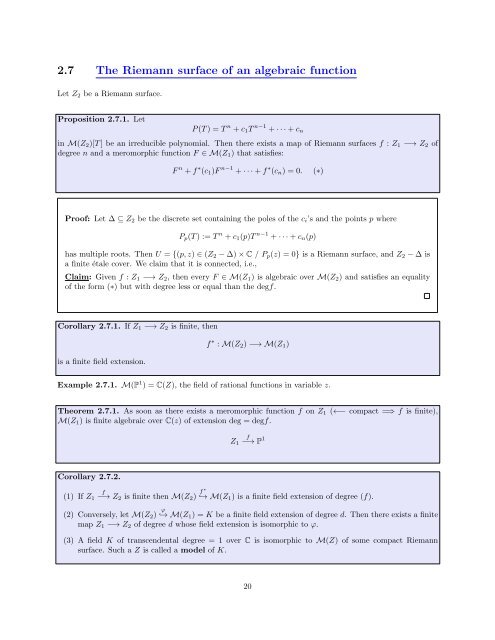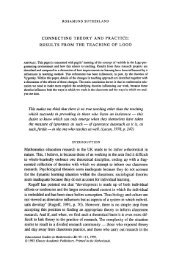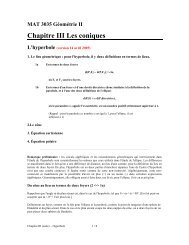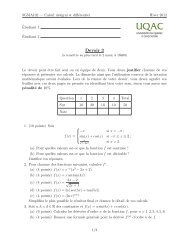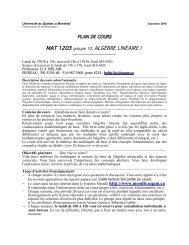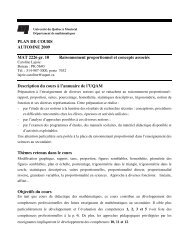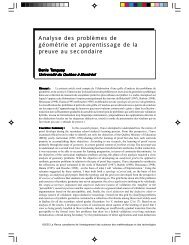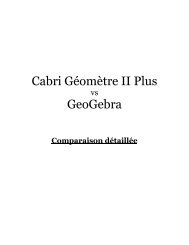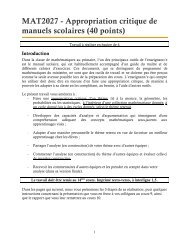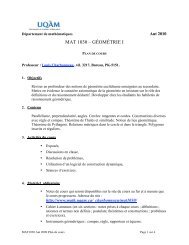COMPLEX GEOMETRY Course notes
COMPLEX GEOMETRY Course notes
COMPLEX GEOMETRY Course notes
You also want an ePaper? Increase the reach of your titles
YUMPU automatically turns print PDFs into web optimized ePapers that Google loves.
2.7 The Riemann surface of an algebraic function<br />
Let Z 2 be a Riemann surface.<br />
Proposition 2.7.1. Let<br />
P (T ) = T n + c 1 T n−1 + · · · + c n<br />
in M(Z 2 )[T ] be an irreducible polynomial. Then there exists a map of Riemann surfaces f : Z 1 −→ Z 2 of<br />
degree n and a meromorphic function F ∈ M(Z 1 ) that satisfies:<br />
F n + f ∗ (c 1 )F n−1 + · · · + f ∗ (c n ) = 0.<br />
(∗)<br />
Proof: Let ∆ ⊆ Z 2 be the discrete set containing the poles of the c i ’s and the points p where<br />
P p (T ) := T n + c 1 (p)T n−1 + · · · + c n (p)<br />
has multiple roots. Then U = {(p, z) ∈ (Z 2 − ∆) × C / P p (z) = 0} is a Riemann surface, and Z 2 − ∆ is<br />
a finite étale cover. We claim that it is connected, i.e.,<br />
Claim: Given f : Z 1 −→ Z 2 , then every F ∈ M(Z 1 ) is algebraic over M(Z 2 ) and satisfies an equality<br />
of the form (∗) but with degree less or equal than the degf.<br />
Corollary 2.7.1. If Z 1 −→ Z 2 is finite, then<br />
is a finite field extension.<br />
f ∗ : M(Z 2 ) −→ M(Z 1 )<br />
Example 2.7.1. M(P 1 ) = C(Z), the field of rational functions in variable z.<br />
Theorem 2.7.1. As soon as there exists a meromorphic function f on Z 1 (←− compact =⇒ f is finite),<br />
M(Z 1 ) is finite algebraic over C(z) of extension deg = degf.<br />
Z 1<br />
f<br />
−→ P 1<br />
Corollary 2.7.2.<br />
(1) If Z 1<br />
f<br />
−→ Z 2 is finite then M(Z 2 ) f ∗<br />
↩→ M(Z 1 ) is a finite field extension of degree (f).<br />
(2) Conversely, let M(Z 2 ) ϕ<br />
↩→ M(Z 1 ) = K be a finite field extension of degree d. Then there exists a finite<br />
map Z 1 −→ Z 2 of degree d whose field extension is isomorphic to ϕ.<br />
(3) A field K of transcendental degree = 1 over C is isomorphic to M(Z) of some compact Riemann<br />
surface. Such a Z is called a model of K.<br />
20


